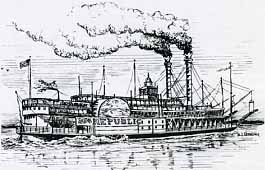
Click Here to Return To Milestones Vol 7 No 2

The early explorers of Beaver County did most of their navigation of the Ohio and Beaver Rivers in boats called bateaux. Later keelboats and flatboats were used; but after Robert Fulton's successful steam navigation on the Hudson in 1807, it was decided to build a boat in Pittsburgh. This was done under the direction of Nicholas Roosevelt of New York, the grandfather of President Theodore Roosevelt. The first steamboat, the New Orleans, was launched on the Ohio River in 1811. THis boat was four days in her maiden trip from Pittsburgh to Louisville, Kentucky.
Difficulties common to navigation in the varying waters of the western rivers were still a deterrent to the success of the venture. It was not until 1816 that the public was persuaded that steam navigation was feasible in these waters. After this date a rapid growth in steamboat building took place.
Up to this time, early navigation of the western rivers was attained with every kind of hardship imaginable. The return trip up stream was especially difficult, oftentimes necessitating the use of poles or sweeps to propel the boats. Frequently, boats were pulled by a rope fastened to the bow. When the nature of the shore was not suitable for walking, the "wrapping" process was employed. In the wrapping process the yawl would be sent out with a coil of rope, which was fastened to a tree or rock on the shore. After this, the crew would then pull the boat up by the line, the yawl in the meantime carrying another line farther ahead to be fastened and used in a like manner. There also was the threat of Indian attacks along the banks of the rivers.
The advent of the steamboat changed all this. By making travel speedy, it made it safe. Also, a better class of boatmen began to be demanded.
Beaver County was noted for it sactivity in this new enterprise. In several places at the mouth of the Beaver River there were numerous boatyards. Hereall kinds of river craft were built, flatboats, cotton boats, keelboats and steamboats. The first to engage in this industry was John Boles, who came to Beaver County sometime in the early eighteen-twenties and settled at the point between Rochester and New Brighton. He built a large boatyard, which constructed flatboats, keelboats and steamboats. In 1826, John Hartman Whisler, one of Bole's employees, became his partner, and to him the following year Bole sold out the business. The business grew rapidly under Whisler's management, the principal construction being keel and cotton boats.
The keelboat was a regular model boat with a prow at both ends. It was build in this manner in order that the boat might run in either direction without turning around. These boats were usually one hundred and ten feet to one hundred and twenty-five feet in length and were finished with what was called a "cargo box." The purpose of this box was to protect the cargo from the weather.
The cotton boats were similar to the keelboats, but seldom exceeded one hundred and ten feet. They were used to carry cotton out of the bayous and small streams in Mississippi.
The principal activity in this enterprise was first at Phillipsburg, where boat building, under the ownership of Phillips and Graham, was the main boat industry during a period of several years prior to 1832. Later they transferred their firm to Freedom, Pennsylvania. There were several other boat-building yards in Beaver County located at Shippingport, Cook's Ferry and Industry.
There were various steamboat building companies in Beaver County, among them Phillips and Graham, who constructed over thirty steamboats. Among the boats built were the Rambler, the Pennsylvania and the New Jersey. There were only four steamboats built by Graham Rogers: the Potomac, the Talma, the Phoenix and the Huron;and only three were built by John Graham at Bridgewater: the Fullston, the Itaska and the Rodney.
The above companies' averaged tonnage was 8,635 tons. The ship carpenter worked at $22 per ton and when finished, $60 per ton.
Boats built in Freedom, Pennsylvania by Phillips and Betz totaled thirty-nine. Among them were the St. Louis, the Detroit, the Oceana and the H. L. Kinney.
The above were mostly boats of large class, tonnage of nearly 12,000 tons, costing nearly $70 per ton.
Lastly, the A. & G.W. Coffin Company of Freedom built boats, including the Little Steward (ferry boat), the Iron City and the Birmingham.
So great was this time and change in river boat transportation that it has been well called "the Steamboat Revolution."